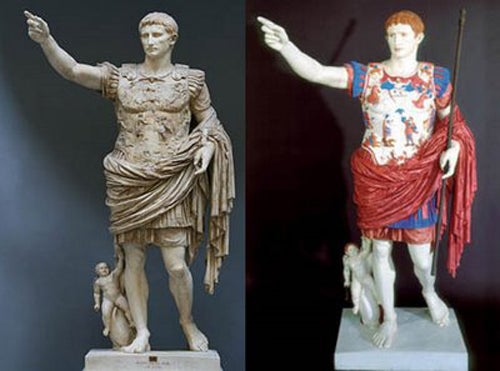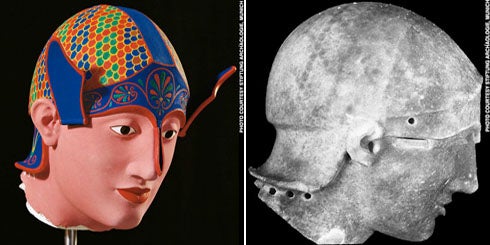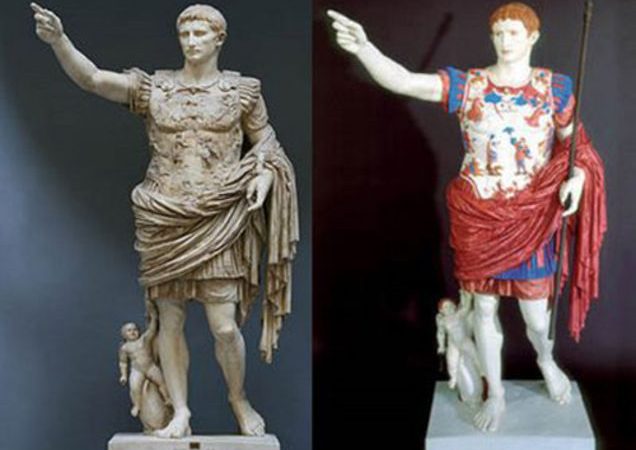Finding the long lost patterns on a piece of ancient Greek sculpture can be as easy as shining a lamp on it.

Original Greek and Roman statues, like Augustus, were brightly painted, but after thousands of years, those paints have worn away. Find out how shining a light on the statues can be all that’s required to see them as they were thousands of years ago.
Although it seems impossible to think that anything could be left to discover after thousands of years of wind, sun, sand, and art students, finding the long lost patterns on a piece of ancient Greek sculpture can be as easy as shining a lamp on it. A technique called ‘raking light’ has been used to analyze art for a long time. A lamp is positioned carefully enough that the path of the light is almost parallel to the surface of the object. When used on paintings, this makes brushstrokes, grit, and dust obvious. On statues, the effect is more subtle. Brush-strokes are impossible to see, but because different paints wear off at different rates, the stone is raised in some places – protected from erosion by its cap of paint – and lowered in others. Elaborate patterns become visible.
Ultraviolet is also used to discern patterns. UV light makes many organic compounds fluoresce. Art dealers use UV lights to check if art has been touched up, since older paints have a lot of organic compounds and modern paints have relatively little. On ancient Greek statues, tiny fragments of pigment still left on the surface glow bright, illuminating more detailed patterns.

Once the pattern is mapped, there is still the problem of figuring out which paint colors to use. A series of dark blues will create a very different effect than gold and pink. Even if enough pigment is left over so that the naked eye can make out a color, a few thousand years can really change a statue’s complexion. There’s no reason to think that color seen today would be anything like the hues the statues were originally painted.
There is a way around this dilemma. The colors may fade over time, but the original materials – plant and animal-derived pigments, crushed stones or shells – still look the same today as they did thousands of years ago. This can also be discovered using light.

Infrared and X-ray spectroscopy can help researchers understand what the paints are made of, and how they looked all that time ago. Spectroscopy relies on the fact that atoms are picky when it comes to what kind of incoming energy they absorb. Certain materials will only accept certain wavelengths of light. Everything else they reflect. Spectroscopes send out a variety of wavelengths, like scouts into a foreign land. Inevitably, a few of these scouts do not come back. By noting which wavelengths are absorbed, scientists can determine what materials the substance is made of. Infrared helps determine organic compounds. X-rays, because of their higher energy level, don’t stop for anything less than the heavier elements, like rocks and minerals. Together, researchers can determine approximately what color a millennia-old statue was painted.
The color? Always something flamboyant!

Via Harvard, Colour Lovers, Tate, The Smithsonian, Colorado University, and Carleton.
Top two images are reconstructions created by Vinzenz Brinkmann.
Source: i09

































13 Comments
John
August 28, 2016, 1:06 amthis is a roman statue of Augustus…just saying…
REPLYSid Goldberg@John
August 28, 2016, 1:46 pmThanks… Will update!
REPLYjason batton@John
January 26, 2020, 4:58 amThe fact this is a statue of Augustus does not make this article any less fascinating.
REPLYLeslie
August 28, 2016, 9:20 amAlthough I think this is great information to spread, as John states, your main image is Roman (not Greek) and therefore your story loses credibility. In fact the statue is a particularly famous one – one that you could have confirmed the origin of with very little effort (even a Google image search). Yes, Roman statues (and buildings) were also painted like the Greek ones, but you don’t mention Ancient Rome at all. I was glad to see that you included a list of links to your sources – thank you. But I do not see the primary image of the Roman Emperor Augustus in any of those links. I think this is a good example of why reliable sources for all material.
REPLYSid Goldberg@Leslie
August 28, 2016, 1:55 pmThanks for the update on Augustus, Leslie. EMN has corrected the article and appreciates the input from astute observers like you. Your input as well as form those who also caught this oversight is always well received.
REPLYJilliann @Sid Goldberg
August 31, 2016, 2:39 amfrom*
REPLYSid Goldberg@Jilliann
August 31, 2016, 10:19 amWhat’s your comment? “from*” ???
REPLYAncient Greece in Living Color | GabeAcevedo.com
August 28, 2016, 4:18 pm[…] like Augustus, were brightly painted, but after thousands of years, those paints have worn away. Find out how shining a light on the statues can be all that’s required to see them as they were thousands of years […]
REPLYMark Stone
August 30, 2016, 9:56 amIf you’re going to go with Augustus as your leading image, you should change the headline to say Roman, not Greek. Roman art was in effect Ancient Roman photography, intended to accurately reflect the subject at hand. For instance, Julius Caesar was pretty irate over a statue made of him that was accurate of his thinning hairline.
As for tacky? Maybe you shouldn’t write about history if you can’t avoid calling things the "Ugly Truth" and "tacky". And seems to me someone whose picture features the amount of lipstick and make-up that the photo for "Around the Web Editor" does might be less judgmental about such things. Otherwise, you come off looking hypocritical.
REPLYSid@Mark Stone
August 30, 2016, 1:04 pmThanks for your input, Mark. As the leading photo chosen is the artist’s representation of Augustus as well as the Greek depictions in the article, the bulk of the study centred on Greek art, thus the headline. You are right, "tacky" is a poor choice of words and we will adjust. Appreciate your perspectives here.
REPLYDrew
August 30, 2016, 3:43 pmHi Sid, just thought I’d stop in, offer up a bunch of pedantic, snotty observations revolving largely around what other people have already said, and call it a day.
REPLYSid@Drew
August 30, 2016, 5:11 pmThanks Drew. We couldn’t do this properly without the input of those reading who know more! Input is always appreciated.
REPLY